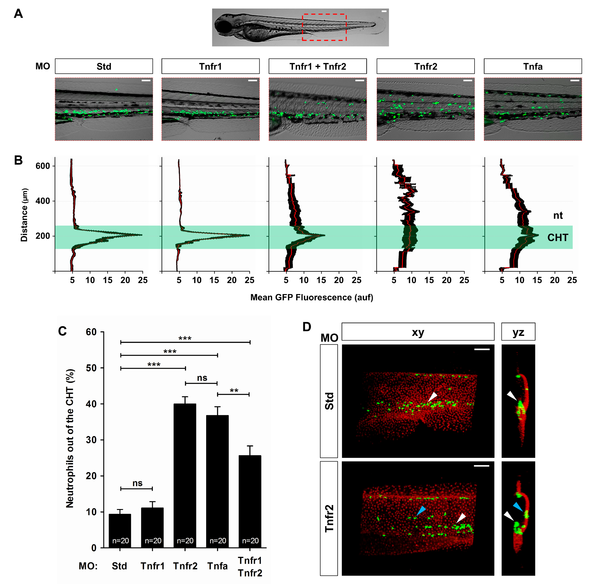Fig. 1
TNFα and Tnfr2 deficiencies result in neutrophil mobilization to the skin.
Zebrafish one-cell mpx:eGFP and/or krt18:RFP embryos were injected with standard control (Std), Tnfr1, Tnfr2, Tnfa, or Tnfr1+Tnfr2 MOs. (A) Representative images, bright field and green channels, of the morphants at 3 dpf showing the differences in the neutrophils distribution. (B) Fluorescence intensity was measured for all the groups in the area indicated (A), which includes the CHT, where most neutrophils are located in wild-type larvae at 3 dpf. The images were converted to a fluorescence value matrix where the value obtained for each pixel transversally was the mean ± S.E.M. for all the pixels for each row (15 larvae per treatment from 3 different experiments). The area corresponding to the CHT has been labeled and highlighted. The notochord (nt) location has been indicated to facilitate the larval orientation. auf, arbitrary units of fluorescence. (C) The neutrophil mobilization from the CHT in Tnfa- and Tnfr2-deficient larvae was quantified as the percentage of neutrophils outside the CHT in 20 larvae per group from 3 different experiments. The mean ± S.E.M. for each group is shown. (D) Representative frontal (xy) and lateral (yz) views of tridimensional reconstructions from confocal microscopy images of WIHC of mpx:eGFP larvae stained at 3 dpf with anti-p63 antibodies (basal keratinocyte marker, red) showing the neutrophils′ distribution in the CHT area of control and Tnfr2-deficient larvae. Note that most neutrophils (eGFP, green) are located in the CHT in control larvae (white arrowheads), while many of them infiltrate the skin (blue arrowheads) of Tnfr2-deficient larvae, whereas they are mainly located in the CHT in their wild-type siblings. Scale bars, 100 µm. ns, not significant. *p<0.05, **p<0.01, ***p<0.001.

